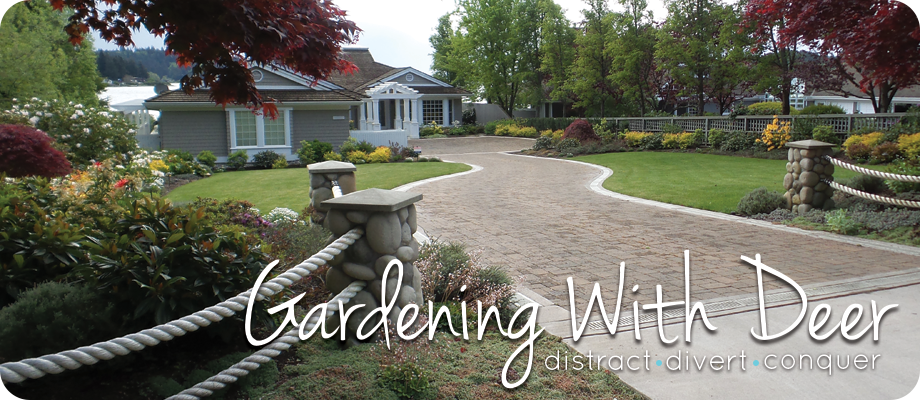
by Susan | May 15, 2015 | LB Tutorial: Design Challenge, Plantswoman Design
Many times clients ask me to design a deer proof garden. On Bainbridge Island there are many deer. They are so rough looking that they look like much loved stuffed animals. You may have heard the old adage that there is no such thing as a deer proof garden. And that can seem true as deer will eat anything if they are hungry enough. All you can really do is plan and experiment to see what works for your area. Sometimes deer at one end of the island will eat different things than the deer at the other end. I’ve seen them leave the hosta to be eaten by slugs (maybe they don’t like slugs either) and eat tender fern and rhododendron leaves. While at other places anything that looks like a hosta is eaten to the ground.
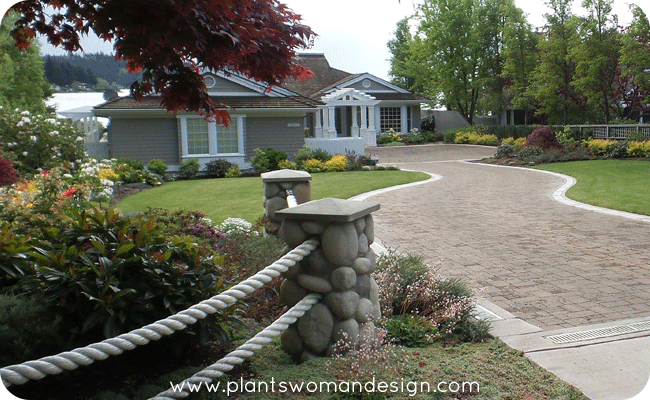 This is a beautiful coastal garden in the Point White area of Bainbridge Island. The clients are not here in the winter but come back in the late spring to the blooms I’ve planned for them.
This is a beautiful coastal garden in the Point White area of Bainbridge Island. The clients are not here in the winter but come back in the late spring to the blooms I’ve planned for them.
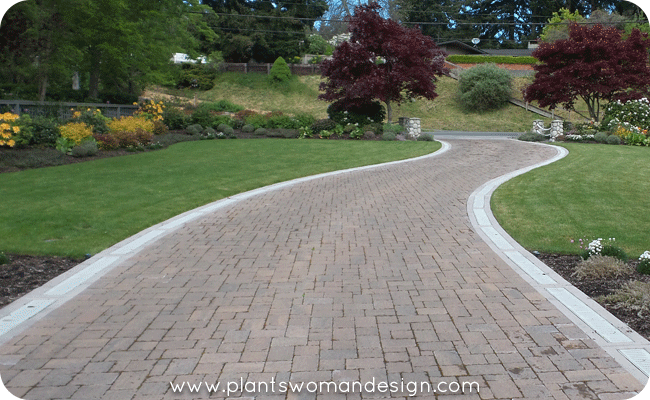 The paver driveway is good for the moist site and any excess water is directed down the edge drains. A combination of grasses, heathers, sedums are on raised berms to keep their feet from getting too wet.
The paver driveway is good for the moist site and any excess water is directed down the edge drains. A combination of grasses, heathers, sedums are on raised berms to keep their feet from getting too wet.
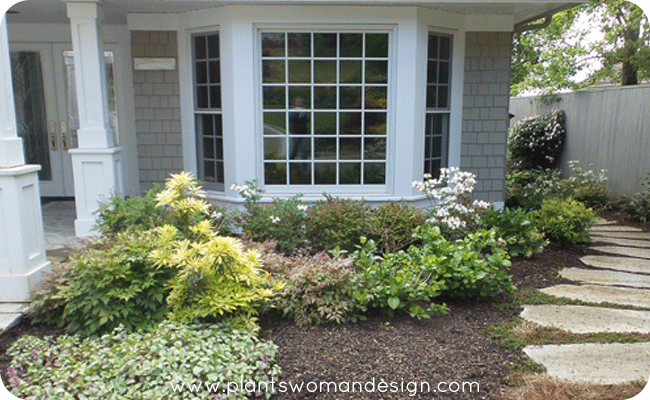 The owners requested evergreens and good blooms, they also love hydrangea (aka deer candy). We tucked these in close to the front door so they can be enjoyed and are less likely to be eaten. One thing the deer have eaten are the blooms off the Bergenia. The leaves are fine but the blooms are gone. Who knew?
The owners requested evergreens and good blooms, they also love hydrangea (aka deer candy). We tucked these in close to the front door so they can be enjoyed and are less likely to be eaten. One thing the deer have eaten are the blooms off the Bergenia. The leaves are fine but the blooms are gone. Who knew?
Here is my go to plant check list:
- Plants with fuzzy leaves like yak hybrid rhododendrons.
- Plants with strong fragrance like lavender, Sarcoccoca, and herbs
- Grasses (sedges really) with edges on the leaves.
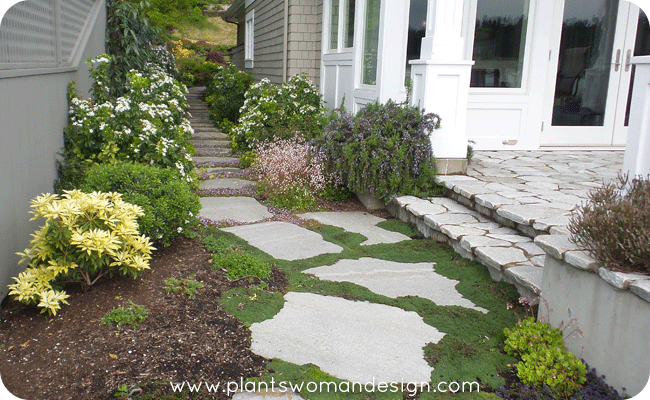 Design Tips:
Design Tips:
Plant ‘must haves’ like hydrangeas close to the house, by a tight side yard, near a patio or screen fencing. Deer like some hydrangeas better than others. Oakleaf will be eaten as soon as there is a leaf showing while paniculatas are often left alone.
Plant Roses on trellises so they bloom above the reach of deer.
Repetition is your friend. Planting something like heather, pine, or Hebe and repeating it gives a great look with less worry about feeding it to the deer.
Put out a couple of sacrificial plants to see what the deer might be eating in your area. You will soon know what their favorite food is. You can always bring it back to the greenhouse, holding area or give it away if you can’t place it.
Plant ‘deer candy’ surrounded by other plants deer don’t like. It often distracts the deer and they will leave it alone. I have one customer that has a beautiful oak leaf hydrangea surrounded by a belt of Berberis thunbergia – Red Barberry. Roses surrounded by Lavender also works.
Get a dog. Even non-aggressive dogs will keep deer away…. I’m just kidding really. Sometimes a digging romping dog is more trouble than the deer!
Share what you do to protect your plants from deer. Maybe you have a different problem like rabbits. They can be devastating too. What are your ‘go to’ tips for dealing with uninvited wild life?
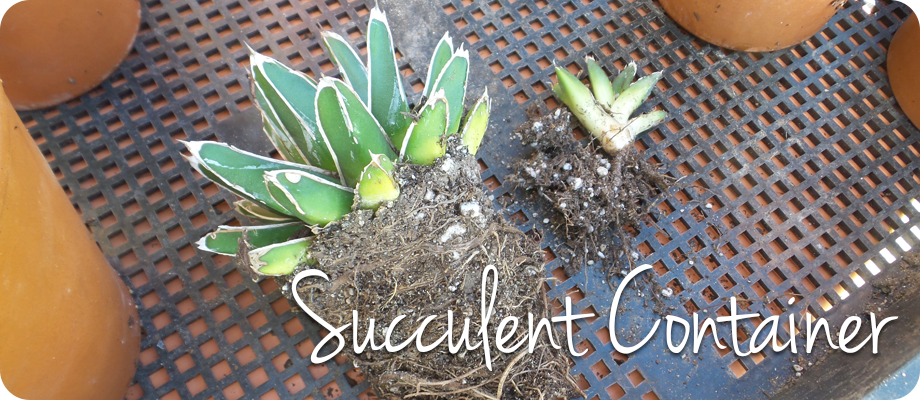
by Susan | May 8, 2015 | LB Tutorial: Container Gardening, Plantswoman Design
Succulents are all the rage right now. Every place I look, from the grocery store to the nursery, I see them. Many of them are not hardy in our area so they are treated like annuals. Surprisingly enough they are not hard to keep alive in your house with reasonable light and very little water.
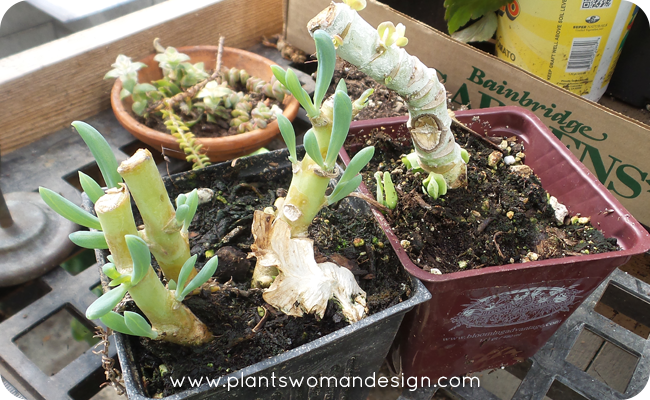 I hate to throw away plants so I try to keep them alive if I can. Now that the weather is getting better I’m ready to bring some of my previous saves back out. Sometimes I pick up a few more to add to the collection. Ready for a quick planting idea that you can engage your kids with?
I hate to throw away plants so I try to keep them alive if I can. Now that the weather is getting better I’m ready to bring some of my previous saves back out. Sometimes I pick up a few more to add to the collection. Ready for a quick planting idea that you can engage your kids with?
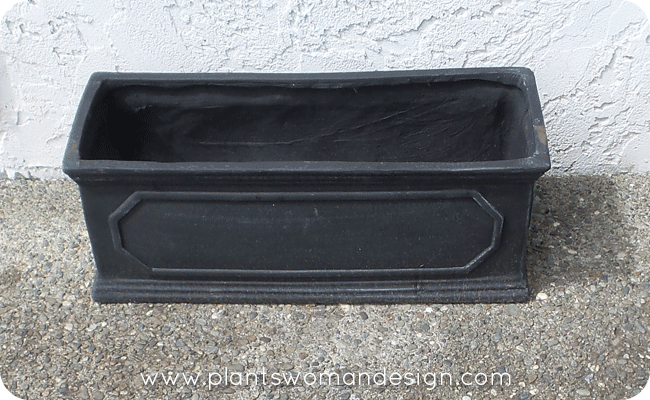 Lowes had a very lightweight rectangular planter. Just perfect for dropping some plants in! First I pushed out the plug in the bottom so the water would drain out. They come with a plug so they can be used as a water planter as well.
Lowes had a very lightweight rectangular planter. Just perfect for dropping some plants in! First I pushed out the plug in the bottom so the water would drain out. They come with a plug so they can be used as a water planter as well.
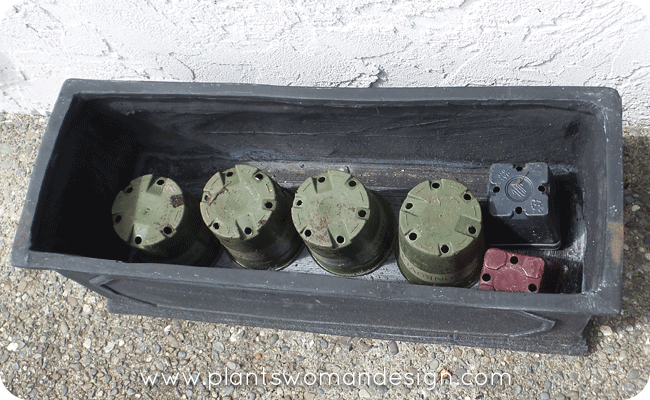 The succulents only need a small amount of soil to survive. The hardest part of keeping them alive is soil saturation from over watering. The way to use a deep container like this is to use a filler of some sort so the soil level is much less than the entire volume of the planter. I have used several types of filler but this time I’m using old 4-inch pots. Dropping them upside down inside the container will leave airspace beneath them and less room for soil above them.
The succulents only need a small amount of soil to survive. The hardest part of keeping them alive is soil saturation from over watering. The way to use a deep container like this is to use a filler of some sort so the soil level is much less than the entire volume of the planter. I have used several types of filler but this time I’m using old 4-inch pots. Dropping them upside down inside the container will leave airspace beneath them and less room for soil above them.
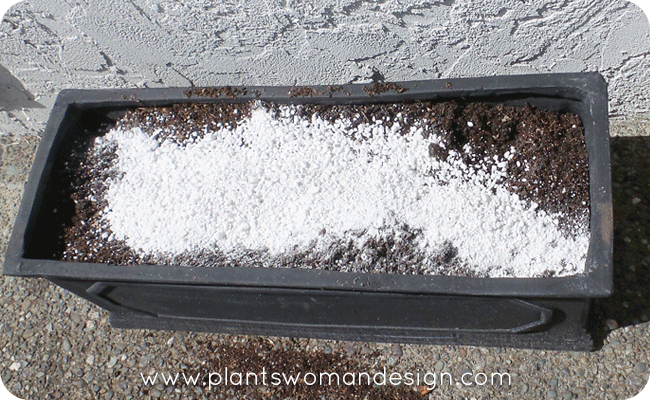 The soil used here is regular potting soil with extra perlite added to increase the air space in the soil. You can use a cactus mix but you can also mix your own soil from all purpose soil mix and adding different amendments.
The soil used here is regular potting soil with extra perlite added to increase the air space in the soil. You can use a cactus mix but you can also mix your own soil from all purpose soil mix and adding different amendments.
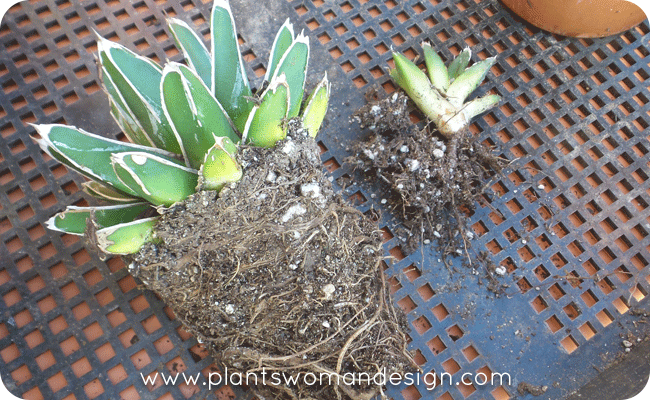
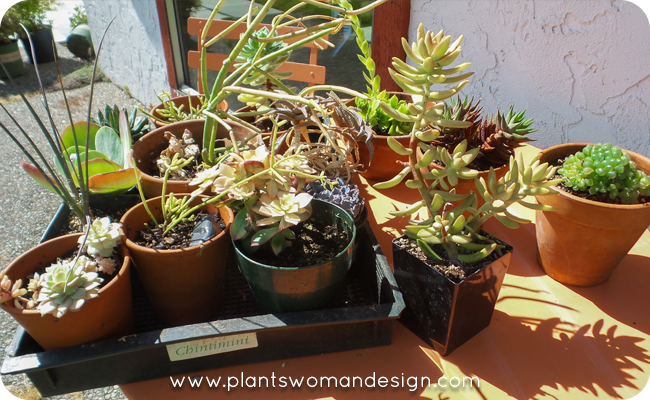 Using what I had over wintered with some new plants I created a little mini garden.
Using what I had over wintered with some new plants I created a little mini garden. 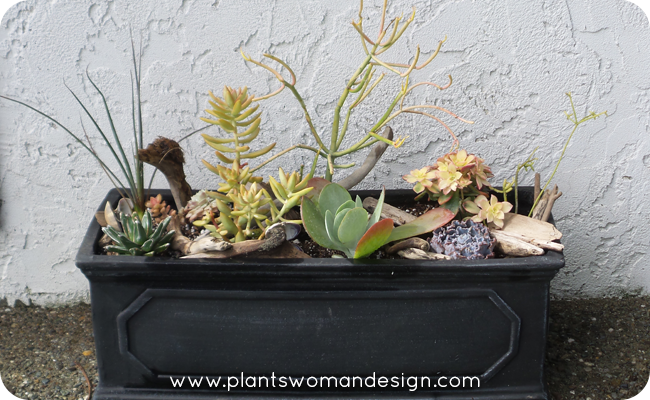 When planting try to plant contrasting leaves next to each other, putting tall things in the center or off center and build the contrasts around them. Firm the soil around the plants and soak the soil to settle it around the plants.
When planting try to plant contrasting leaves next to each other, putting tall things in the center or off center and build the contrasts around them. Firm the soil around the plants and soak the soil to settle it around the plants.
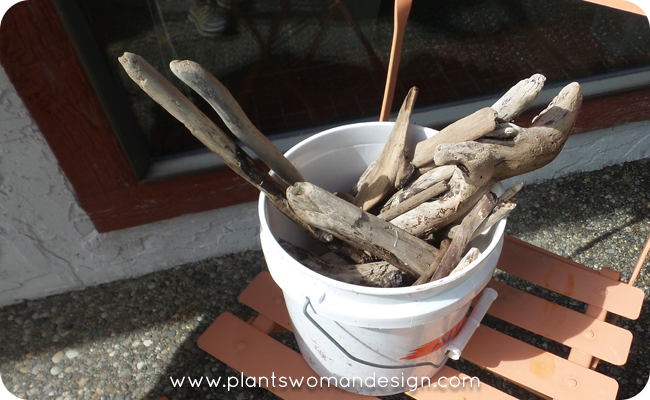 For the finishing touch I grabbed some pieces of driftwood, and shells from the beach. This is the perfect opportunity to have your kids help. My grand kids are always picking up rocks and sticks from their outdoor adventures and these collections can be added to the top of the planter to act as mulch. Ask your kids to add what they’ve collected on top of the soil. Rocks, sticks, beach glass, feathers, seedpods, whatever they come up with is so much fun. I usually have the worse time keeping my puppy from dragging out a couple of pieces to chew.
For the finishing touch I grabbed some pieces of driftwood, and shells from the beach. This is the perfect opportunity to have your kids help. My grand kids are always picking up rocks and sticks from their outdoor adventures and these collections can be added to the top of the planter to act as mulch. Ask your kids to add what they’ve collected on top of the soil. Rocks, sticks, beach glass, feathers, seedpods, whatever they come up with is so much fun. I usually have the worse time keeping my puppy from dragging out a couple of pieces to chew.
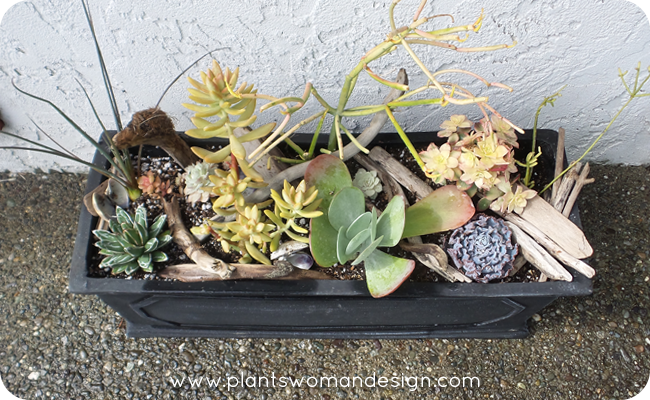 Do you have succulents? How have you displayed them?
Do you have succulents? How have you displayed them?
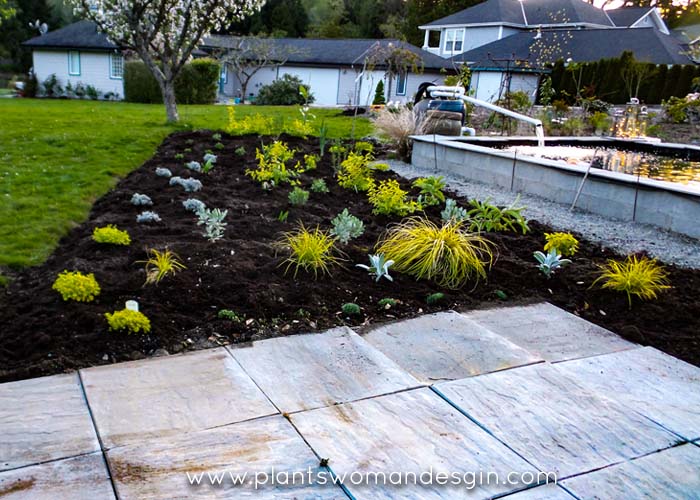
by Susan | May 1, 2015 | LB Tutorial: Skills, Plantswoman Design
Many of my clients have heard me say, “I don’t put it in your garden unless I’ve grown it myself.’ I am always experimenting and trying out new plants. After one Northwest Flower and Garden Show the sales rep from Encore gave me several varieties of Encore Azaleas. I tucked them into my garden and gave them a year to grow on to see how they survived a winter. Of the seven varieties I received, two did well, and five didn’t do so well. The ones that did well bloomed well, recovered from a cold winter, and looked good coming out of it. The five that didn’t do so well looked bad, they struggled through the winter and didn’t bloom. Because of this field test, I was able to add two azaleas to my pallet of plants which I still use today.
But, because of my field testing, my garden can look a little haphazard. Sometimes I will put a plant in two different areas to test drainage, hardiness, or sun/shade. Or plant three or more of the same species of plant in various colors together. Experimentation is exciting when plants that are not hardy survive, unexpected color combinations present themselves, and learning that not giving a plant everything it wants keeps it under control. Dead plants will always be a design flaw. Invasive plants are also a design flaw.
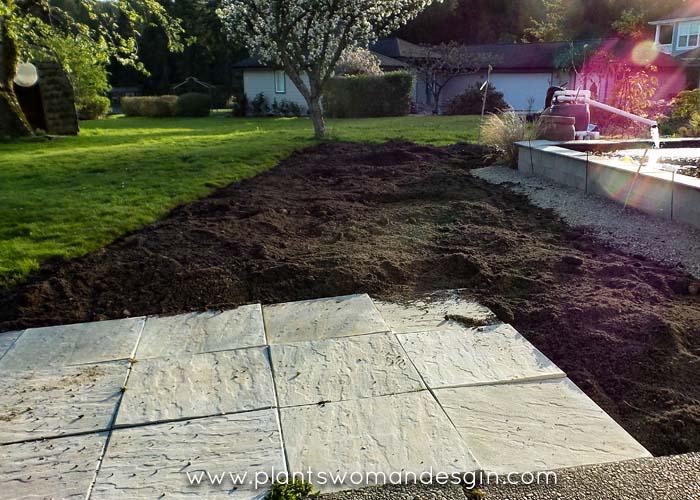
Pictured above is a newly created bed in my garden. As I contemplate the design for this bed, I’m taking a walk in my client’s shoes. The result is a design that would satisfy many of my customers. Striving for a minimal color pallet in leaf color, bloom and texture it looks and will look amazing. All the foliage in the bed is bright green and blue-gray. The flowers will be either white or lavender and blue. I dropped in three contrast plants to make the bed continue to pop in the late summer. A gray leafed Lobelia tupa with a brick red flower, and colocasia sangria, a gray leafed elephant ear with a red stem, and a low groundcover geranium ‘Hocus Pocus’ with a dark red leaf and blue flower.

Here’s how I planned this bed along with 5 useful tips for designing your garden bed.
1. Choose for height. There are higher plants in the center with graduating heights toward the edges. The far end of the bed has a taller section with an evergreen Eriobothrya japonica (Loquat) for screening from the neighbor.
2. Choose evergreen, deciduous, and perennial plants. I want to be sure that the bed looks good year-round. This bed is right in front of the window that looks towards the koi pond. So I made sure to strike a balance between all the elements so there are no big blank spots that would show up in the winter or summer because of dormancy.
3. Choosing color and texture. I pay close attention to the play of texture and color in leaves. The balance of texture between the Carex ‘Evergold’ and Stachys Bella Grigio’s blooms is just as exciting as the contrast in leaf color. The spikes of Agapanthus ‘Blue Leap’ between Lavender ‘Richard Gray’ and Spirea ‘White Gold’ are also an exciting combination.
4. Bloom time. Surprising enough, the last thing that gets consideration from me is the flowers. Because there are so many great plants to choose from, it is easy to get the flower color right. Early blooms from the geranium and the campanula ‘Dickensens Gold’ will be the first to show here. The Agapanthus, Lavender, and Centaurea simplicicaulis will be next. Later season blooms will be Caryopteris ‘Dark Knight’, Salvia elegans ‘Gold’ and the Lobelia Tupa.
5. Site considerations (AKA where is the sun). Usually, this is pretty easy to define. Sometimes you can add something that likes shelter behind something more prominent. The Lobelia tupa wants to have shelter, so I planted the Pittisprorum ‘Blue Wave’ between the water and the lobelia. This arrangement should protect the lobelia from the brunt of the weather.
Variations in the number of plants are flexible and entirely up to the designer. Repetition of plants creates rhythm and looks natural because, in nature, plants do seed around and create groups.
Plant List for Hot and Bright!
Lobelia Tupa, Caryopteris ‘Dark Knight’, Agapanthus ‘Blue Leap’, Spirea ‘White Gold’, Geranium ‘Hocus Pocus’, Campanula ‘Dickenson Gold’, Carex ‘Evergold’, Colcasia ‘Sangria’, Lavender Richard Gray, Centaurea simplicicaulis, Salvia elegans ‘Gold’, Pervoskia atripicifolia, Stachys ‘Bella Grigio’, Saxifraga crustata, Salvia nemerosa ‘Blue Marvel’, Panicum ‘Ruby Ribbions’.
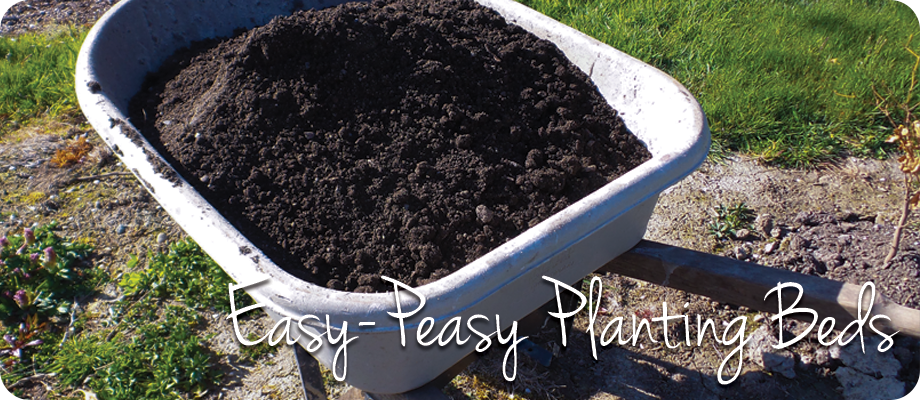
by Susan | Apr 24, 2015 | LB Tutorial: Skills
One of the most amazing things about gardening is the way that gardeners share information. We are (and should be) willing to share methods and tips about gardening, things that worked for us and things that didn’t. What I want to share with you today is a gardening method that was shared with me by a great gardener over 15 years ago.
I was just out of college and was beginning to realize all that I didn’t know about gardening. Many people think they know so much when they get out of college, ready to tackle anything. I quickly found out that people who had been gardening since before I was born actually did know more than me. Ah, the arrogance of youth defeated!
Karen had been slowly reclaiming her forested plot into garden one bed at a time. She would plan out where she wanted the bed, clear it of sticks, large clumps of foliage (just cut back), and move anything worth saving. We have a small appliance company on the island and she would ‘recycle’ their cardboard by taking what she needed from the dumpster (original recycling at work). Several layers of cardboard with staples and tape removed would be laid on the ground where the planting bed would be. Mulch was next, at least 3 inches of mulch was laid over the top. She would use whatever she had and purchase what she did not. Wood chips from a fallen tree, leaf litter and manure were the usual materials. Sometimes there would be enough compost from her compost pile to use as well. If there were only woody materials she would add good compost mulch to the top. The materials would then be thoroughly soaked with water, making sure that the cardboard beneath was wet through. Then she just walked away. Amazing! In just 4 – 6 months the bed would be ready for planting. The weeds, plants, and grass in the bed were dead, the cardboard was gone and the bed was full of worms and great airy soil.
Admittedly I was a skeptic, until I tried it myself. Now if I can wait and don’t need to plant immediately I do this same method. In fact I used it last year to put in a late veg garden after I moved into my new house, 4th of July Garden. Because I was planting the bed right away I piled all the soil needed for the veg beds on top of the cardboard, about 6 inches, and planted away. Vegetables only need about that much soil to be successful. The raised edges of the beds held the soil in.
Now as I’m planning and planting the edges of my property I’m working on some areas to get them ready but don’t need to plant anytime soon. In the edge behind the west planting bed I wanted to get rid of a grass strip between my neighbor and I.
Here is a step-by-step guide for creating a planting bed the easy-peasy way.
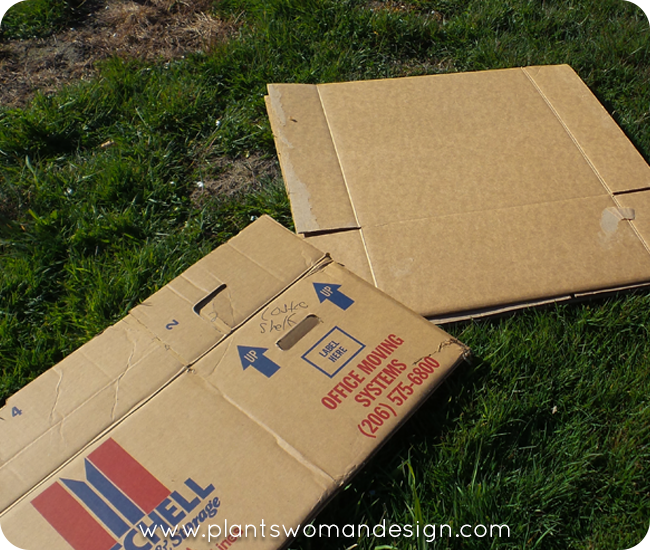
- Collect cardboard or newspaper. A layer of cardboard is a good choice but paper grocery sacks, newspaper and other recyclables can be used. No glossy magazines or plastic coated cardboard.
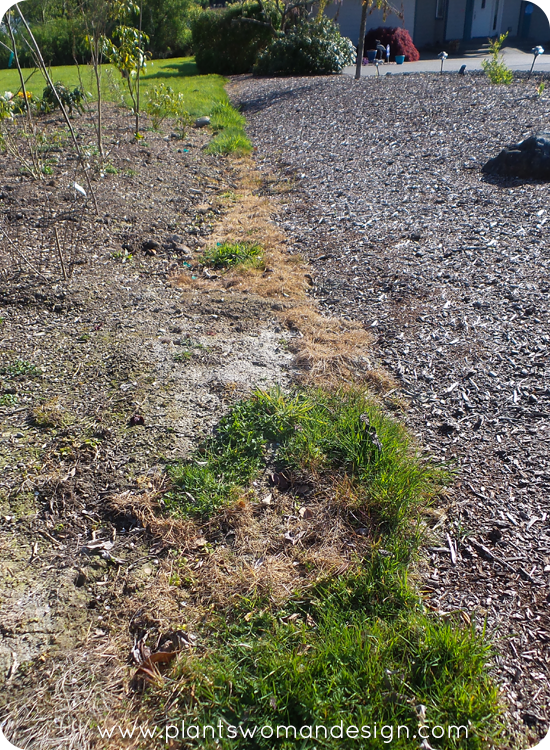
- Clear away any debris. Leave weeds, grass, bark mulch, etc. Warning- this method may not kill horsetail. It will lie dormant under it until you dig in the soil and will start again. It has killed every other weed I’ve covered.
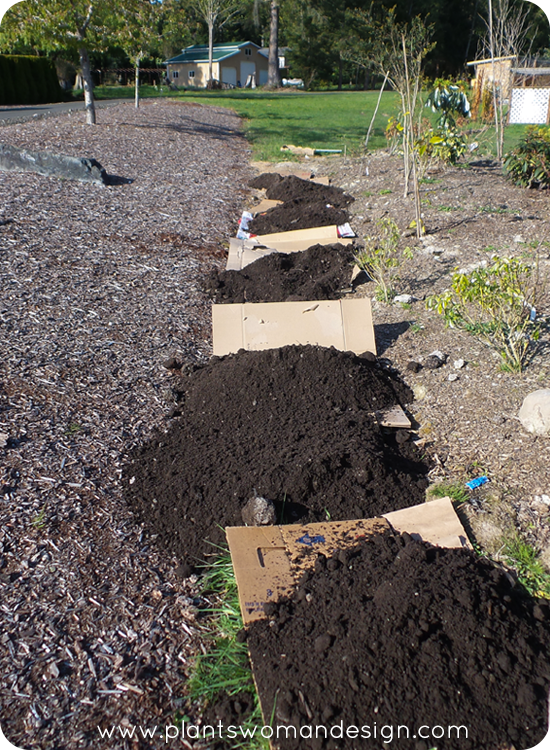
- Layer paper material. It should be at least 1 inch thick. Cardboard can have just two layers.
- Add composted material to the top of the cardboard at least 6 inches thick. I did not have any other materials so I used Fish Compost from our local supplier. If you do this in the fall there are lots of materials to use. The added benefit is that it is ready in the spring to plant. I can always add to the top as things become available.
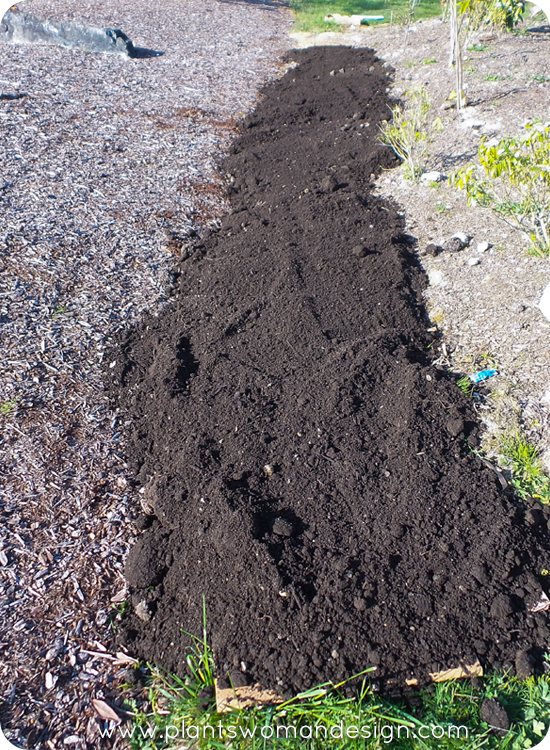
- Water the whole thing in good. In the summer you will probably have to water it occasionally to keep it moist. The worms will come and live in the cardboard and paper material and do the work for you. The lack of light and heat from compost will kill the weeds and the action of worms as they create habitat will give you good worm casings and organic material as it all breaks down.
- Walk away. Check the moisture level occasionally and watch for blown in weed seeds.
Have you have tried this method before? I love it because it actually looks finished and it’s not. I have so much work to do here that some finished looking beds are a good thing.
Sharing the love of gardening and tried and true methods of gardening is really an added benefit of gardening. The social aspect of sharing plants, secrets and swapping stories never grows old and broadens our viewpoint.
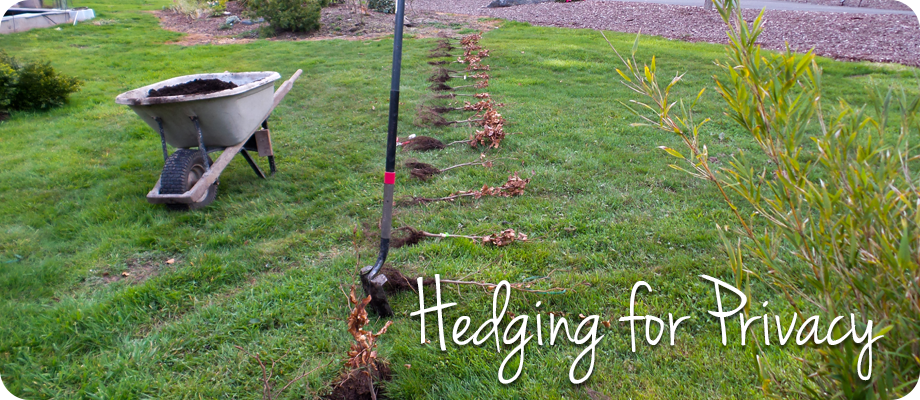
by Susan | Apr 18, 2015 | LB Tutorial: Design Challenge
As many of you know I design and love beach gardens. When meeting with clients I always discuss several possible areas for sitting. So often they say they want to sit with the view of the water, obviously, that’s why they bought the property in the first place. But as anyone who lives close to the water knows there can be major fluctuations in climate between the different areas of your garden. The front of the garden facing the water can be windy and cold in the morning but warm in the evening, or warm in the morning and cool in the evening. Extremes in temperatures, wind, and sun need to be intentionally planned for. Having multiple areas for sitting and gathering provides a way to be outside whenever possible and that is important.
This winter has proven an eye opening (or eye closing) experience. Here is what I’ve learned…
- The wind is strong off the water even when elsewhere in the county there is no wind. (yes I said county…)
- The structure of the house is sound and has the ability to withstand the wind. The garden has to be the same way.
- The view to the water must be maintained but the exposure to the elements tamed, quite a challenge.
As I worked on an area in the back of the house I was reminded of my design suggestions I mentioned in the post What Comes First The Plant or the Plan. I have not thought this would ever be an area where I would hang out as it is behind the house with access through the kitchen door. It was the logical place for the BBQ but more of a ‘dart out there and do it’, than a destination. Two things this winter have changed my mind: 1. The seemingly constant wind and 2. The western exposure. Wind from the water is blocked by the house and the sun swings around the side of the house and ends up behind it. There are no windows on that side so I didn’t realize how sheltered it was until I was working over there. Hmm (which comes first the plant or the plan )….. While this little corner does not have a spectacular view of the sunset there is bit of water and the sky is lovely as the sun slips over the horizon. The back of the house retains warmth from the last bit of sun and actually provides a great place to sit in the eventide.
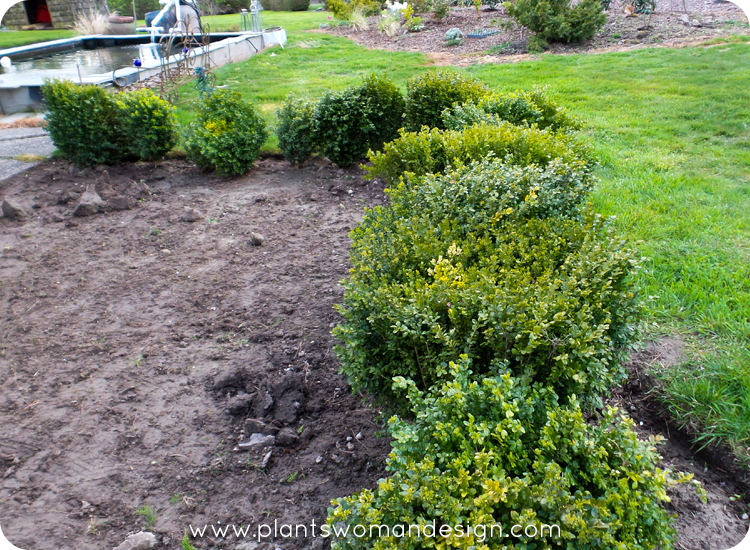 Now I had to plan for privacy from the neighbor’s driveway. When you don’t spend a lot of time in the back of your house there is not that great of need for privacy. The grass has been removed from the area and a boxwood hedge has been placed around the squared off area and I could see more screening would be needed, further away and a little taller.
Now I had to plan for privacy from the neighbor’s driveway. When you don’t spend a lot of time in the back of your house there is not that great of need for privacy. The grass has been removed from the area and a boxwood hedge has been placed around the squared off area and I could see more screening would be needed, further away and a little taller.
 The driveway behind goes at an angle but I did not use that angle to plan the line for the hedge. I picked an angle off the house that runs parallel to the house and repeats the line of the boxwood hedge. It is stepped back from the boxwood about 20 feet and connects to the propane tank covered area. I left a space for walking and mowing (will not mow this area eventually) and marked out the spacing for the hedging.
The driveway behind goes at an angle but I did not use that angle to plan the line for the hedge. I picked an angle off the house that runs parallel to the house and repeats the line of the boxwood hedge. It is stepped back from the boxwood about 20 feet and connects to the propane tank covered area. I left a space for walking and mowing (will not mow this area eventually) and marked out the spacing for the hedging.
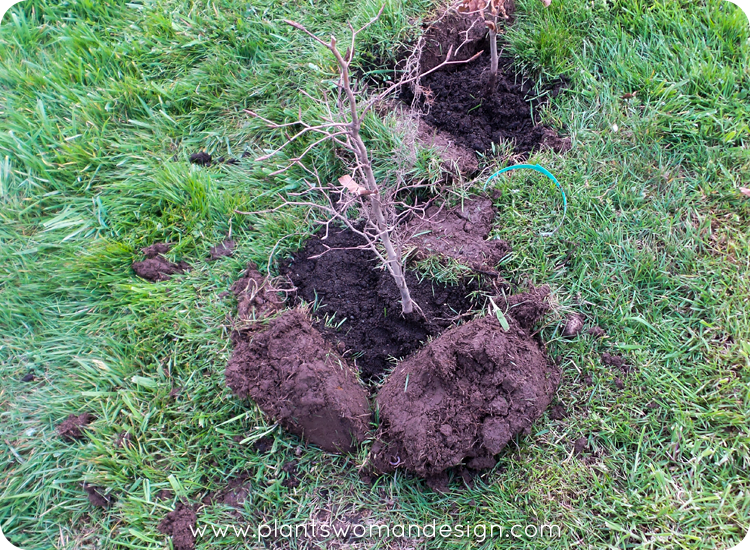 It is early enough in the spring to get bare root plants still. Fagus sylvatica was my choice for the plant material. Measuring the area I placed the plants at equal distance apart and started to dig holes. This area is not totally cleared and prepped for the planting but because it is a hedge the ground can be worked after the plants have been established. Sometimes you just have to get plants into the ground and work the ground around it later.
It is early enough in the spring to get bare root plants still. Fagus sylvatica was my choice for the plant material. Measuring the area I placed the plants at equal distance apart and started to dig holes. This area is not totally cleared and prepped for the planting but because it is a hedge the ground can be worked after the plants have been established. Sometimes you just have to get plants into the ground and work the ground around it later. 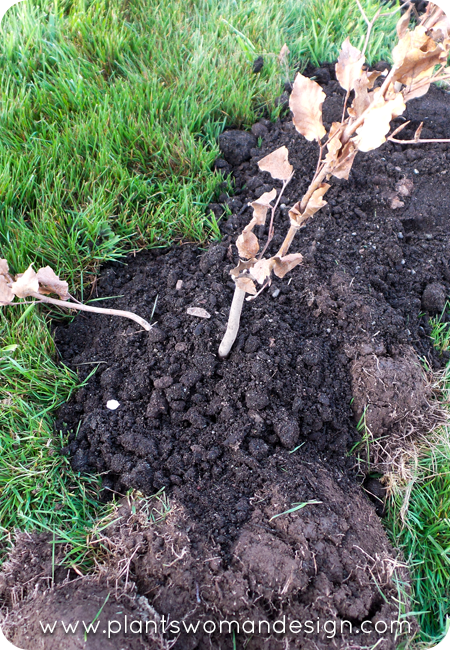 As you can see the holes were dug and the edges of the grass removed were just turn over and placed on the downhill side of the hole. Although not a big slope it does provide a little bit of a well for the water to remain around the plants. The soil in the hole was mixed with a good compost/soil mix I use in all my beds. The roots were then spread out over the soil mound in the hole and back filled with more good soil. Firm tamping down of the soil around the roots insures good soil connection with the roots. Yippee! The hedge has been ‘laid’ in English gardening terms. Later the lumpy grass clods will break down, and can be raked out. A great method for creating planting beds with cardboard and mulch will finish off the project (watch for this in an up coming post, ‘The Easy Peasy Planting Bed’). In the meantime here are some additional tips for planning your own privacy hedge.
As you can see the holes were dug and the edges of the grass removed were just turn over and placed on the downhill side of the hole. Although not a big slope it does provide a little bit of a well for the water to remain around the plants. The soil in the hole was mixed with a good compost/soil mix I use in all my beds. The roots were then spread out over the soil mound in the hole and back filled with more good soil. Firm tamping down of the soil around the roots insures good soil connection with the roots. Yippee! The hedge has been ‘laid’ in English gardening terms. Later the lumpy grass clods will break down, and can be raked out. A great method for creating planting beds with cardboard and mulch will finish off the project (watch for this in an up coming post, ‘The Easy Peasy Planting Bed’). In the meantime here are some additional tips for planning your own privacy hedge.
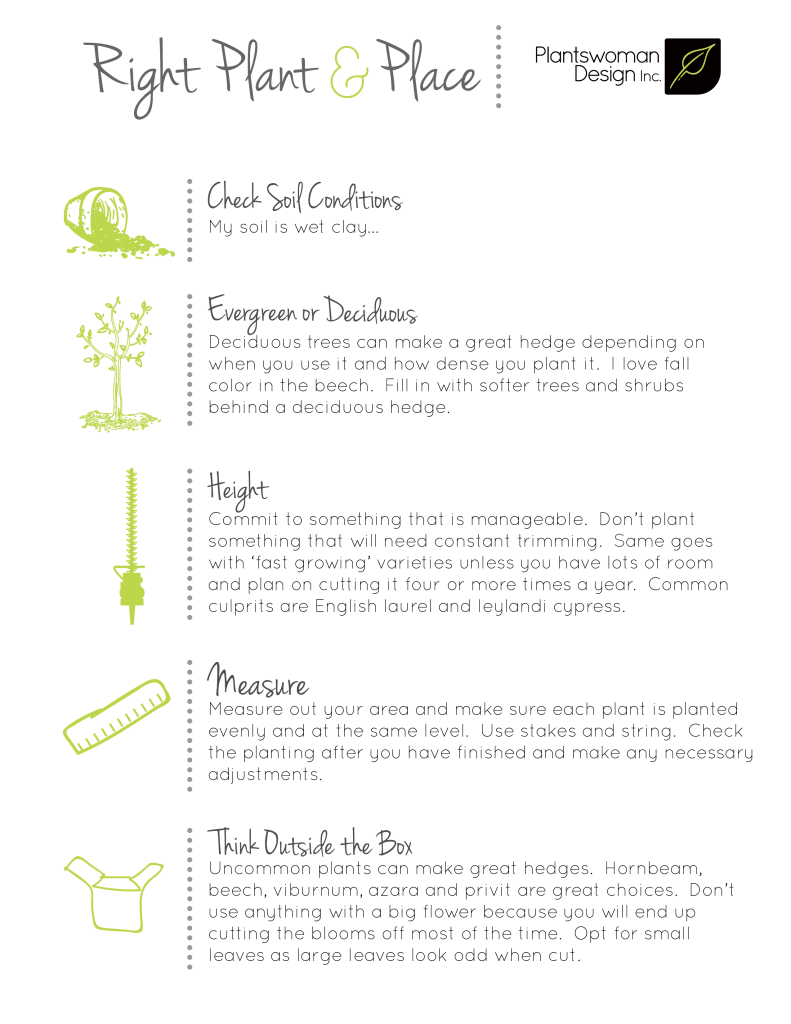
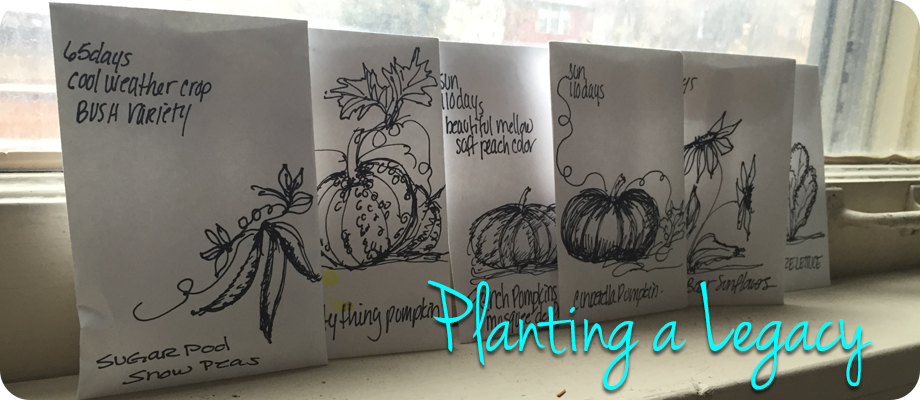
by Susan | Apr 10, 2015 | LB Tutorial: Growing Food
“Planting a Legacy” may be a strange name maybe for a post about seed packets for the kids but… maybe not. Many of my clients want suggestions for how to encourage kids and grandkids to have an interest in gardening. There is a huge decline in the number of students entering the gardening studies. At the same time we are all becoming more aware of where our food comes from, how far away and at what cost to the environment. To participate in the food cycle we should also encourage our children to grow something at home. Food, flowers, strange and wonderful plants, or trees. This helps ground our kids in the earth and give them an appreciation of all growing and living things.
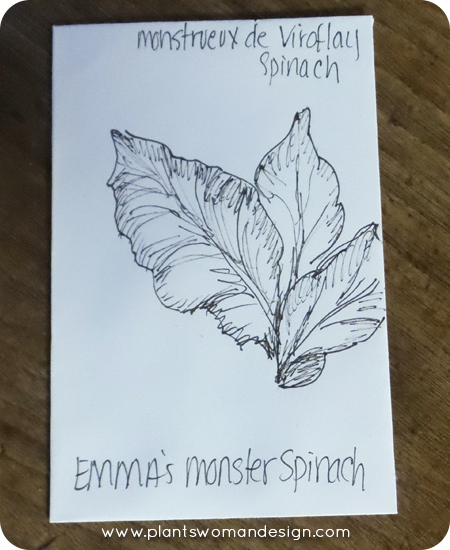
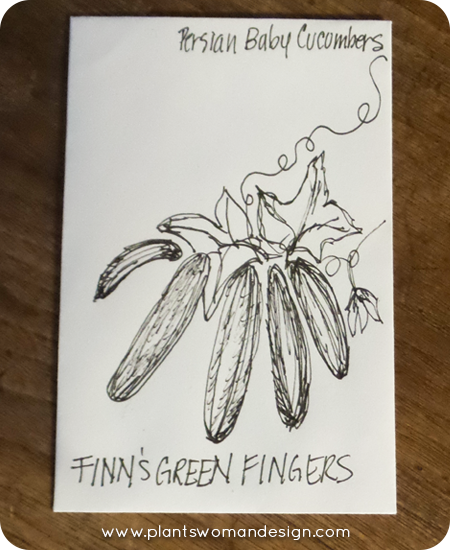 A fun thing I did for my grandkids this year was to make custom seed packets for them to color and to plant. They were excited to color it and see what the plant would look like. I even changed the common name on the package so it became even more personal. Persian Baby Cucumber called Green Fingers became Finn’s Green Fingers. The Monstrueux de Viroflay or Monster Spinach became Emma’s Monster Spinach.
A fun thing I did for my grandkids this year was to make custom seed packets for them to color and to plant. They were excited to color it and see what the plant would look like. I even changed the common name on the package so it became even more personal. Persian Baby Cucumber called Green Fingers became Finn’s Green Fingers. The Monstrueux de Viroflay or Monster Spinach became Emma’s Monster Spinach.
I will have more packages for the seed saving after the harvest of the vegetables and they will be ready to collect and save the seeds for next year.
You can either do your own (I found the blank seed envelopes online as you can see there are many options) or download our free ones below to make your own and let the kids color them! Let’s do more to encourage the kids to grow something.
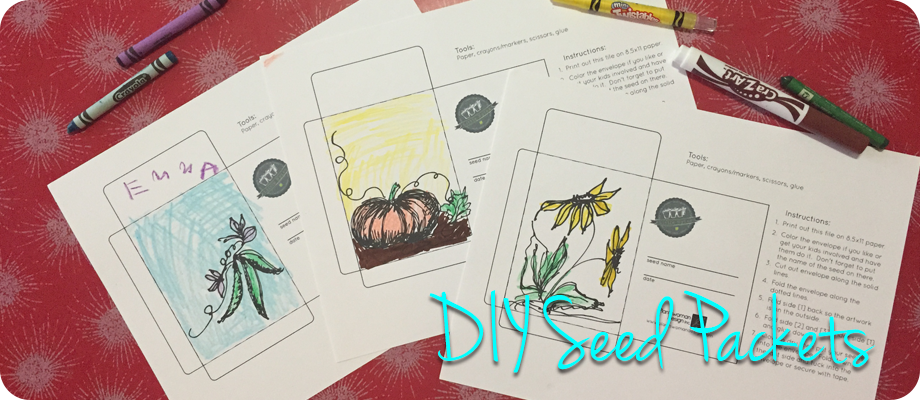
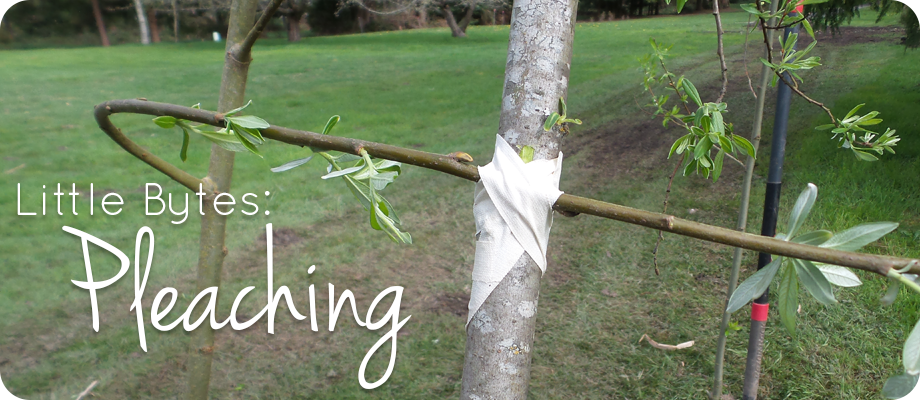
by Susan | Apr 3, 2015 | LB Tutorial: Skills
 In the
In the blog ‘progress yes progress’ I wrote about pleaching my espalier cherry trees into each other. I thought it would be good to talk about pleaching and also create something fun for Little Bytes at the same time.
blog ‘progress yes progress’ I wrote about pleaching my espalier cherry trees into each other. I thought it would be good to talk about pleaching and also create something fun for Little Bytes at the same time.
Pleaching is a type of pruning that causes two branches grow together. It is used in creating espalier fences, living fences and living art pieces. For Little Bytes I thought it would be fun to create a living hide out for kids. My grandkids will be here this summer (I hope) and they will be so excited to have the play structure to play in.
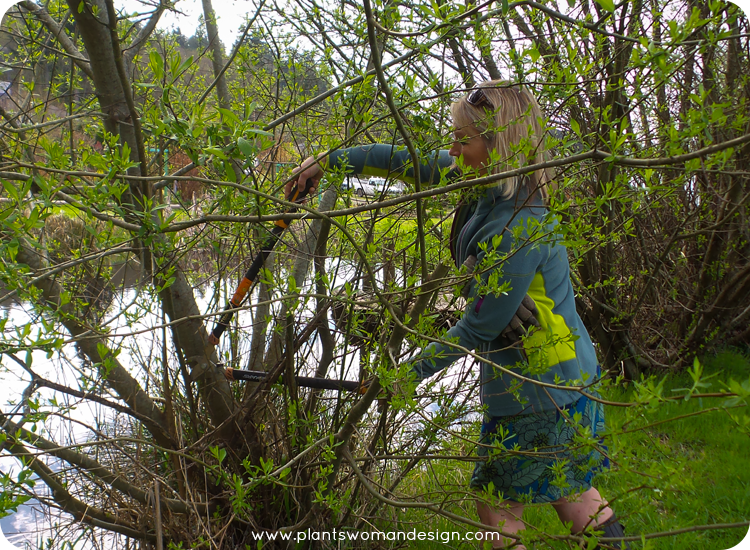 Here you can see I’m cutting off some branches off a willow tree next to the upper pond. I’m choosing willow because it is really easy to work with, it roots easily, it will be easy to pleach and since it grows on my property it’s free!
Here you can see I’m cutting off some branches off a willow tree next to the upper pond. I’m choosing willow because it is really easy to work with, it roots easily, it will be easy to pleach and since it grows on my property it’s free!
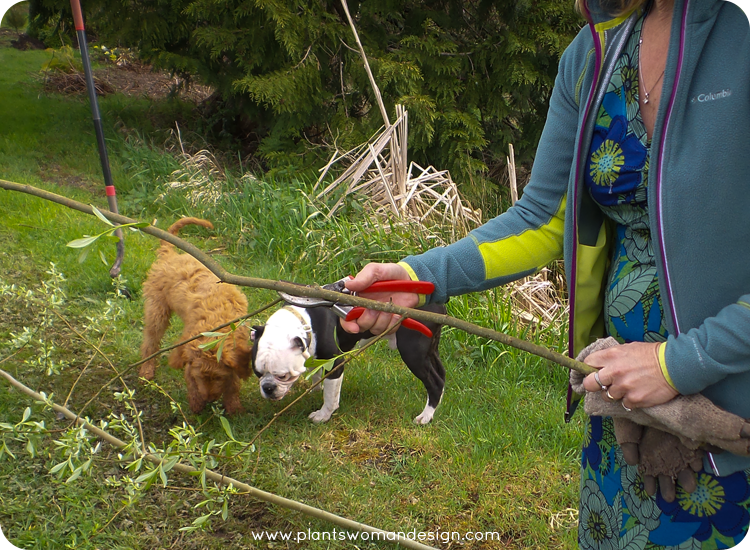 Choose long pieces and trim off lower branches. I left some of the upper branches because we will intertwine them and tie them together. You can see our helpers in the background.
Choose long pieces and trim off lower branches. I left some of the upper branches because we will intertwine them and tie them together. You can see our helpers in the background.
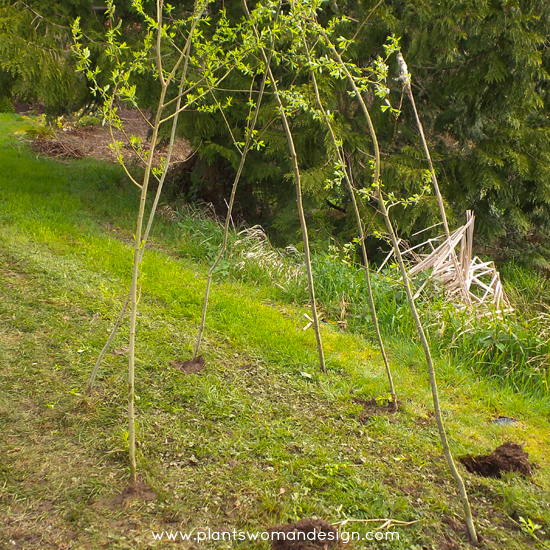 To make your hide-out lay out a circle and check the inner size, I had my assistant stand in the middle of it to make sure it would be big enough for two kids. (Thanks Jen)
To make your hide-out lay out a circle and check the inner size, I had my assistant stand in the middle of it to make sure it would be big enough for two kids. (Thanks Jen)
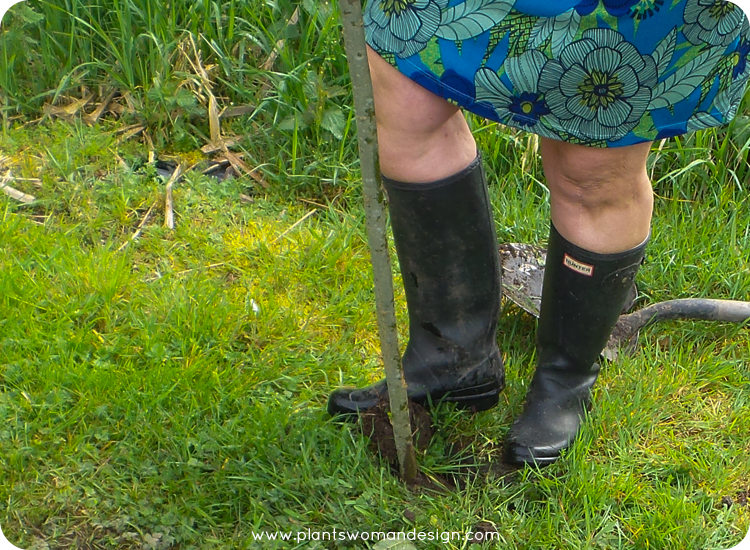 Using the shovel dig holes about 6 – 10 inches deep along the path you have laid out. Place the long willow pieces in the holes and stomp down the soil around them. This is a very wet area so the muddy soil held well. I planned the entrance to face the side yard with the pond behind the tepee. I was worried that some tumbling around might land the kids in the water so…. let’s be on the safe side!
Using the shovel dig holes about 6 – 10 inches deep along the path you have laid out. Place the long willow pieces in the holes and stomp down the soil around them. This is a very wet area so the muddy soil held well. I planned the entrance to face the side yard with the pond behind the tepee. I was worried that some tumbling around might land the kids in the water so…. let’s be on the safe side!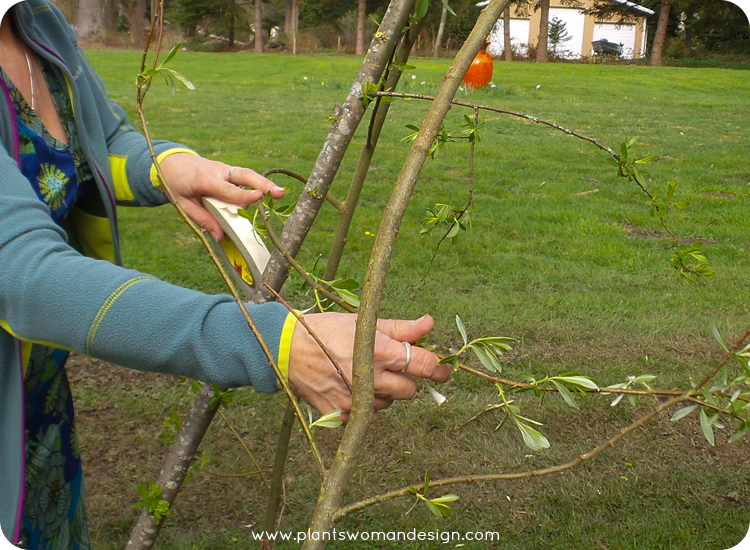
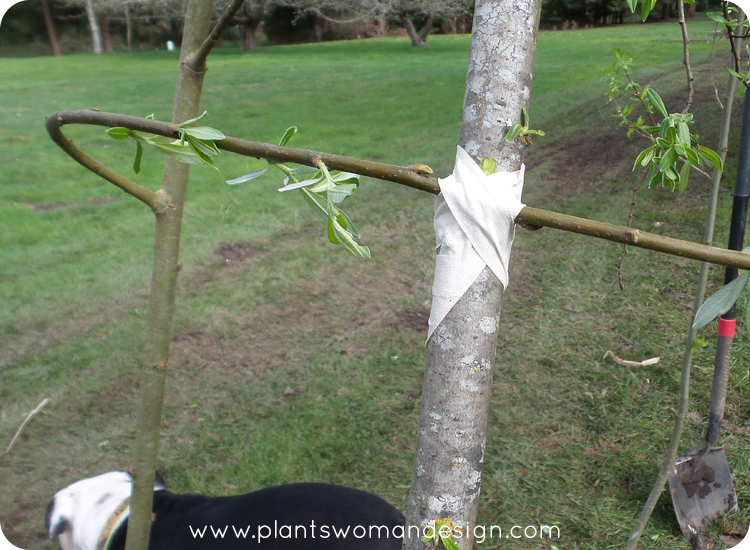 Using the upper branches that are still left and start weaving them together. Using the tape to secure them together.
Using the upper branches that are still left and start weaving them together. Using the tape to secure them together.
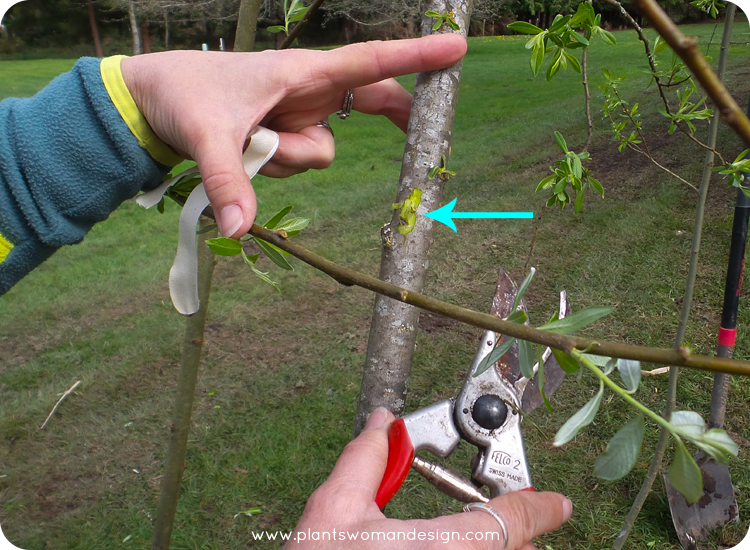
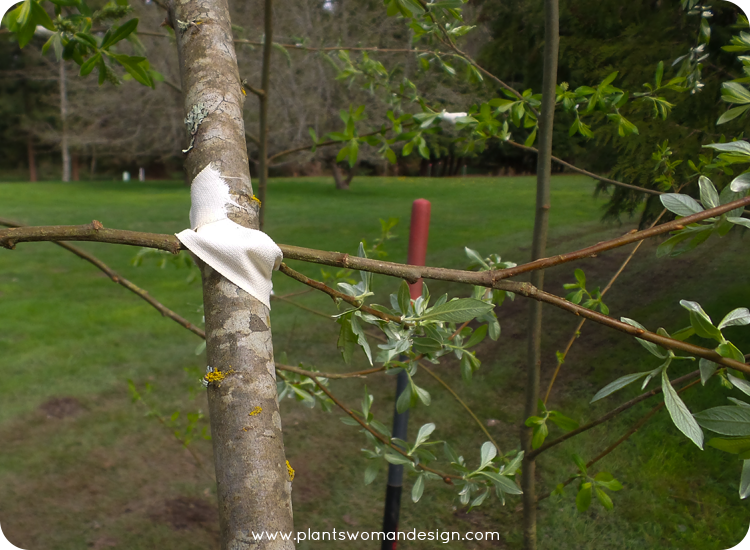 Choosing the strongest branches make a little cut on both sides of the branches and then put the cut edges together. Use the tape to secure the branches together so they are tight.
Choosing the strongest branches make a little cut on both sides of the branches and then put the cut edges together. Use the tape to secure the branches together so they are tight.
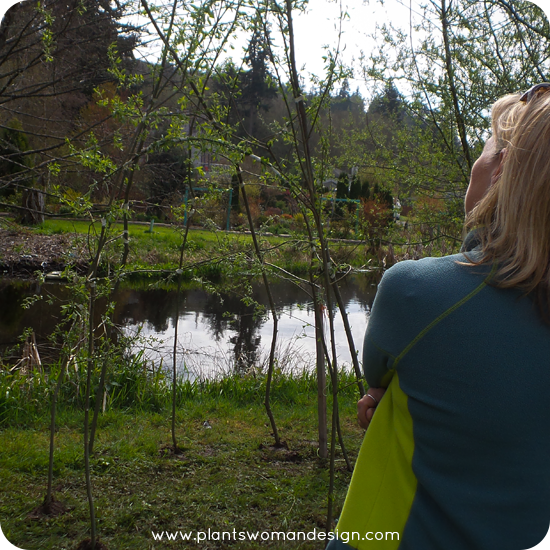 Using the tape and weaving method connect the rest of the branches together. Now there is some danger of the grafts not taking because the willow have been cut and may not root out. I took some of the cuttings I didn’t use and put them into water to root them conventionally and will use them to re-graft later if necessary.
Using the tape and weaving method connect the rest of the branches together. Now there is some danger of the grafts not taking because the willow have been cut and may not root out. I took some of the cuttings I didn’t use and put them into water to root them conventionally and will use them to re-graft later if necessary.
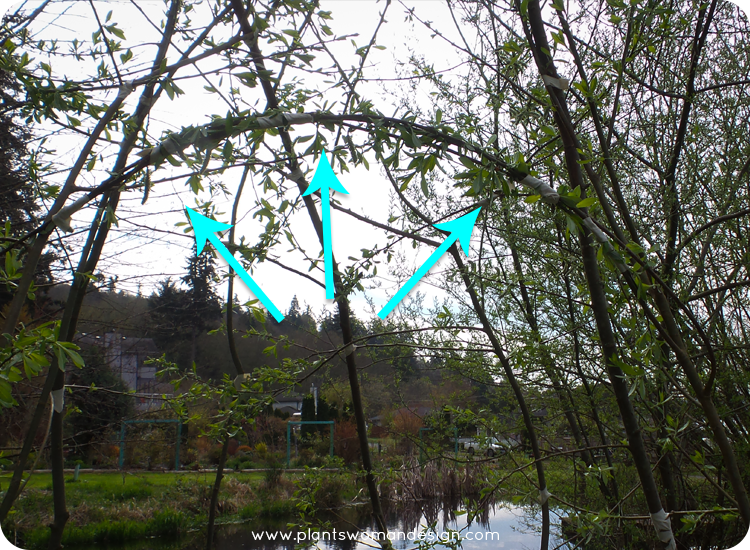 Here is a close up of the archway entrance. You can see the tape holding all the pleached branches together.
Here is a close up of the archway entrance. You can see the tape holding all the pleached branches together.
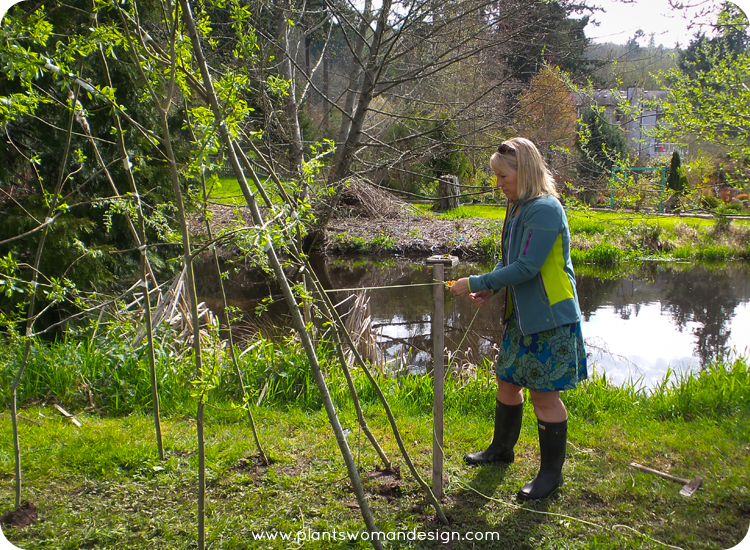 Place a stake towards the windward side of your tepee if needed. The structure will be weak until it is rooted in. I’ll keep you posted on how it roots in. The wax tape will fall off after about a year.
Place a stake towards the windward side of your tepee if needed. The structure will be weak until it is rooted in. I’ll keep you posted on how it roots in. The wax tape will fall off after about a year.
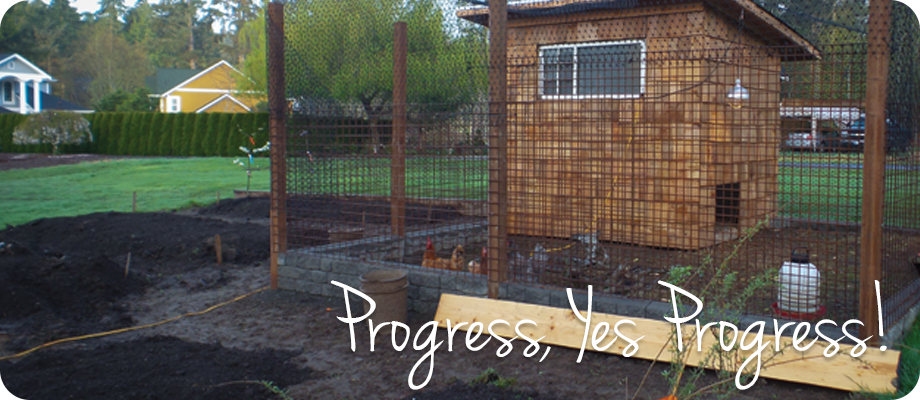
by Susan | Apr 3, 2015 | LB Tutorial: Design Challenge
 I often tell my clients when we meet that I come in and make a big mess before I put it back together again. That has to happen at my house too. Last week I pulled up all the metal pieces that I had for the vegetable garden.
I often tell my clients when we meet that I come in and make a big mess before I put it back together again. That has to happen at my house too. Last week I pulled up all the metal pieces that I had for the vegetable garden.
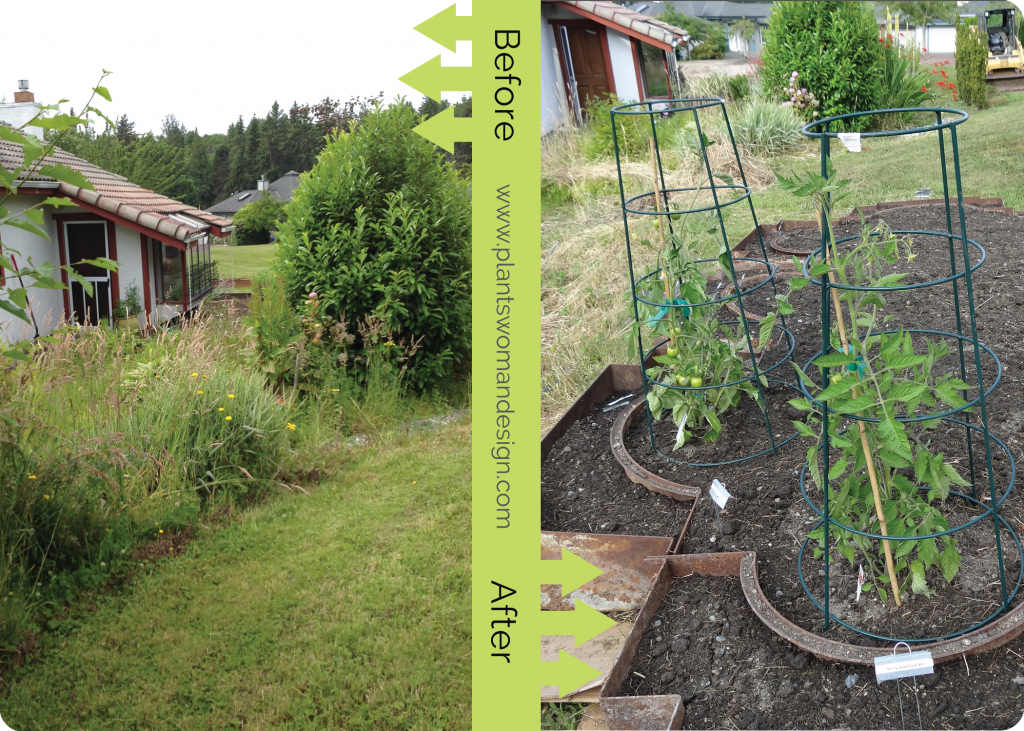
before: when I first moved in | after: metal edged garden
I removed grass (little bites at a time right?) and moved soil into beds. You can see the new chicken coop in the background. It is still a work in progress too (watch for a feature on the chicken coop soon).
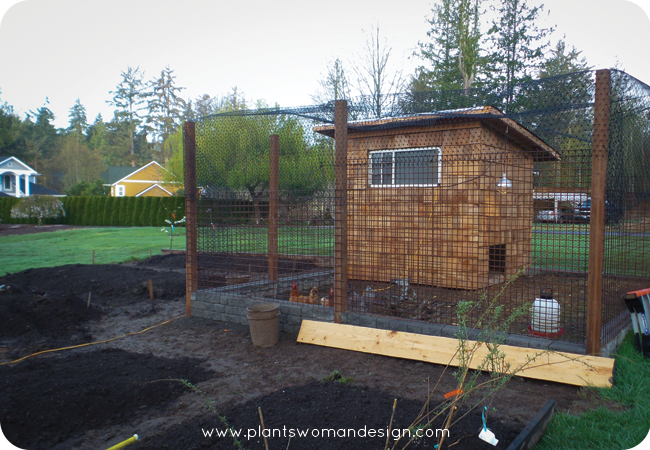 Spring is early this year and I’m looking forward to getting the vegetable garden planted. Several of my friends have looked at it and commented on the size. Yes it is a lot of dirt for just one person. BUT I have a method to my madness. There are several community service opportunities in planting vegetable gardens for the homeless and food bank participants.
Spring is early this year and I’m looking forward to getting the vegetable garden planted. Several of my friends have looked at it and commented on the size. Yes it is a lot of dirt for just one person. BUT I have a method to my madness. There are several community service opportunities in planting vegetable gardens for the homeless and food bank participants.
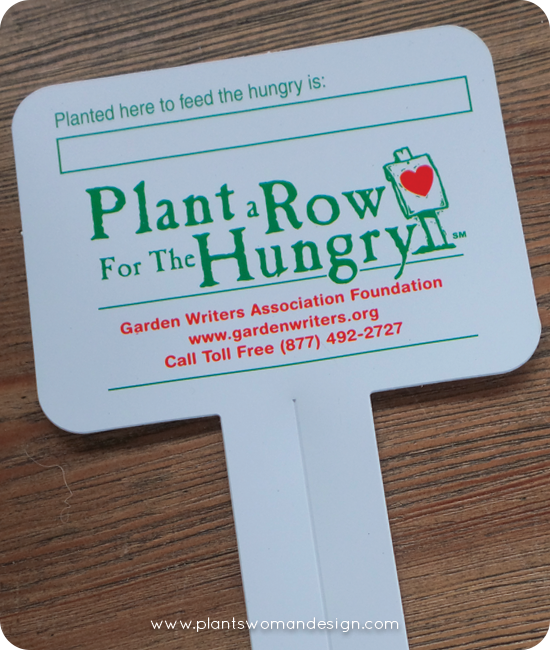 One such program is ‘Plant a Row for the Hungry’ by the Garden Writer’s Association of America. They encourage gardeners to not simply give away their excess but actually plant a row specifically for that reason. A great local resource is the Solid Ground website www.solid-ground.org. This web site has information about Seattle’s Giving Garden Network, P-Patch programs and Lettuce Link. In 2014 these community gardens donated 55,198 pounds of fruits and vegetables. We can all do our part too.
One such program is ‘Plant a Row for the Hungry’ by the Garden Writer’s Association of America. They encourage gardeners to not simply give away their excess but actually plant a row specifically for that reason. A great local resource is the Solid Ground website www.solid-ground.org. This web site has information about Seattle’s Giving Garden Network, P-Patch programs and Lettuce Link. In 2014 these community gardens donated 55,198 pounds of fruits and vegetables. We can all do our part too.
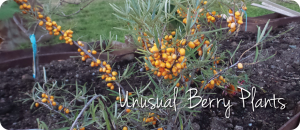
click here to read
For right now the soil is ready. I have to add some borders around the edges to keep the grass out and contain the soil and gravel. I will add gravel pathways for now and eventually put in pavers. The long beds will be the main vegetable beds. A shorter bed to the east will have the gogi berries from last year (click on the picture to read that post) along with rhubarb, blue berries, and raspberries.
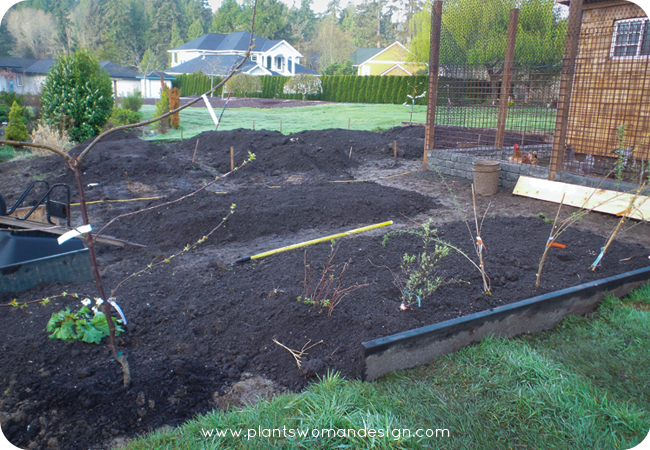 The corner has been planted with two espalier cherry trees and have three different types of cherries on the same tree. My vision is to weave the branches together and graft (called pleaching) them into a living fence in the corner.
The corner has been planted with two espalier cherry trees and have three different types of cherries on the same tree. My vision is to weave the branches together and graft (called pleaching) them into a living fence in the corner.
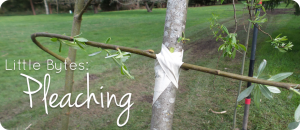
click here to read
Pleaching is a simple type of grafting. Weaving and shaping branches in this way is an ancient practice farmers have been doing for centuries. By carefully interweaving plants, clever (and patient) gardeners have made gorgeous, functional, long-lasting structures out of trees and vines.
Grafting is easier than you think! It requires a sharp knife and some grafting tape or electrical tape. Creating a willow tent for kids play area will be a fun project that I will try first. Using something that is easily grafted like willow or red twig dogwood is the best for a first project. Fortunately I have many willows on the property so using them is easy.
The other side has two espalier pear trees in a row. One more is needed to satisfy my des ign brain. An old gate will go into the area between the row and the Chicken coop.
ign brain. An old gate will go into the area between the row and the Chicken coop.
One of the biggest challenges is the soil on the bank between the greenhouse and the vegetable garden. It is very yucky clay soil and very wet. I had thought to put herbs there but because herbs mostly like dry soil that will not work. It would be a great place for Asparagus but the soil is not great so I’m not sure they would be happy there. A small wall could be created and the soil filled back in, so many choices. This is one of those times when leaving it alone is a good idea. Creating a pathway and a ramp will be necessary for travel back and forth. Working on a problem in design can be frustrating unless you take your time to think the problem through. Not doing anything until you come up with the exact right idea is better than doing the wrong thing a couple of times. I will admit sometimes I’m impatient and just want it finished and that usually gets me in trouble.
I’ll keep you posted on my projects as they progress. What projects are you working on this spring? Are you going to try pleaching with me?
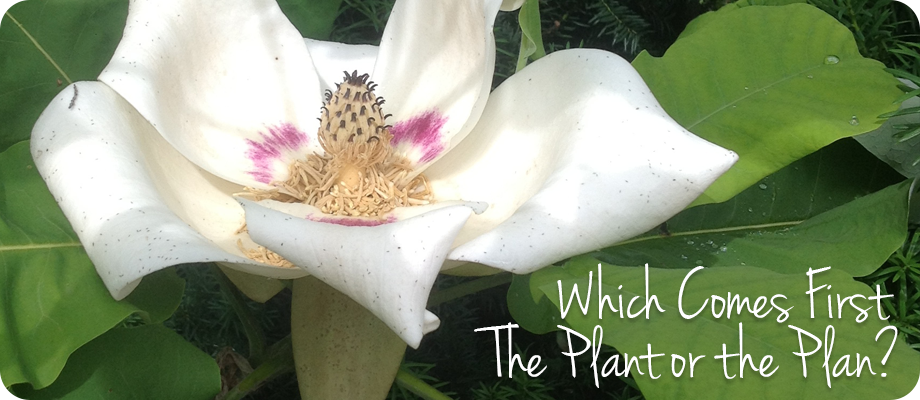
by Susan | Mar 18, 2015 | plants
Many of you know I left my beautiful garden last year to move to a new location. It has been a wonderful move with so many changes in perspective and light. The new owner of my old house (and garden) is so amazed by the cycle of bloom that she posts a daily bloom. Yep, every day she sends me (and a list of other people) pictures of what is in bloom in ‘her’ garden. I actually love that she loves the garden. Her enthusiasm is very rewarding and infectious. It constantly reminds me of things I loved in that garden and sets me on a course to find some of the things again. As the spring approaches I can’t help but plan or is it buy?
A load of good soil has been sitting at the top of my property for about two weeks. It needs to be spread around and things planted in it! A trip to Wells Medina Nursery to gather things for a job resulted in a car load of plants to come back to me. Things I loved were added to my car along with new things I didn’t have room for in my old garden. Do I have a plan? Sort of.. Kind of.. I know what and I need…. I don’t know that I can resist buying plants when I see them, love them, and know I have a place for them.
So there is the problem. Then to make matters worse, while checking the names from the tags of my new plants on the internet, I ran across a website called ‘Plant Lust‘. REALLY…. Like I need to look at that! It is a website that sources rare and unusual plants from 56 nurseries that sell via mail order. Oh GREAT! So now I have not just great nurseries in my area but the UPS driver can also visit me often.
Here are a few of my favorite things I found this weekend:
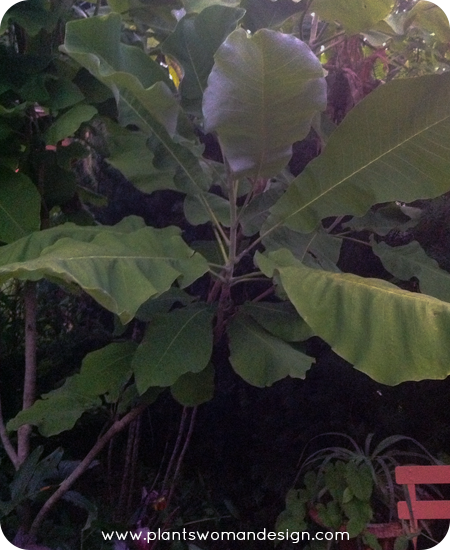
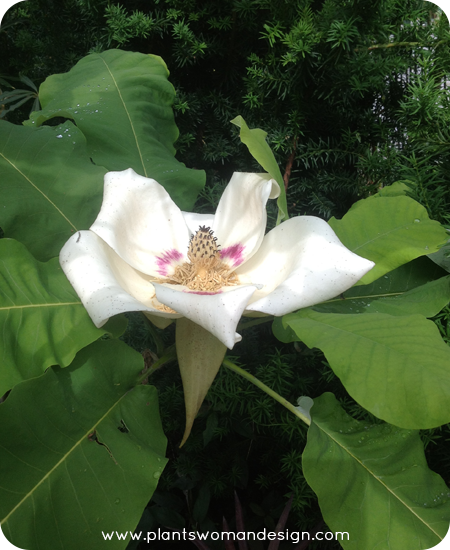 Magnolia Macrophylla. A little stick was what it was when I planted it. It looked like a stick in the winter for 3 winters. Last year it had branches and 3 blooms. Lemon scent streamed throughout the spring garden coming from the 12 inch blossoms. Amazing and worth the wait. I now have another stick.
Magnolia Macrophylla. A little stick was what it was when I planted it. It looked like a stick in the winter for 3 winters. Last year it had branches and 3 blooms. Lemon scent streamed throughout the spring garden coming from the 12 inch blossoms. Amazing and worth the wait. I now have another stick.
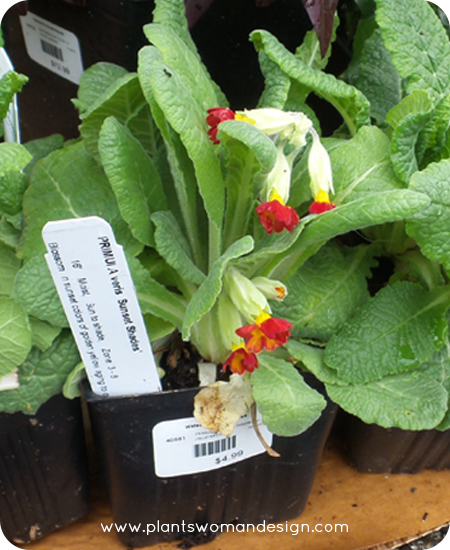 Primula Veris ‘Sunset Shades’ – a diminutive sweet primrose that spreads into the cracks in the garden. Not the cracks in paving or pathways but the spaces between plants that need filling in. The leaves have a blue tinge to them and the orange flowers are bright to begin with and fade to a dull red that is also amazing.
Primula Veris ‘Sunset Shades’ – a diminutive sweet primrose that spreads into the cracks in the garden. Not the cracks in paving or pathways but the spaces between plants that need filling in. The leaves have a blue tinge to them and the orange flowers are bright to begin with and fade to a dull red that is also amazing.
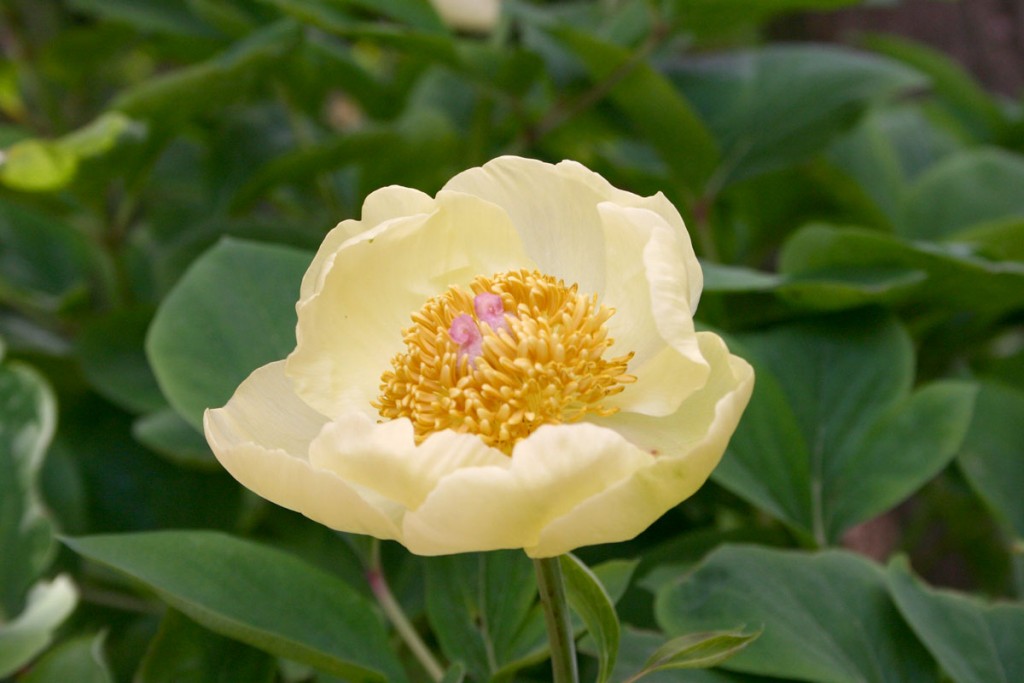
Photo by Rictor Norton & David Allen via Flickr
Paeonia mlokosewitschii – Molly the Witch Peony – This has a long and crazy story in my garden. I first fell in love with this plant in England at the Harlow Carr Botanical Garden. It was a peony in a cage. It is such a beautiful peony that the visitors to the garden would always steal the seeds from the plant even before the seed pods were mature. Yes those little old ladies and gentlemen wanted it and wanted it free. A metal fence wrapped around the whole plant to keep the longest of arms from reaching it. When I got back I started on my own quest to find the plant. I then understood how hard it was to find and was ready to fly back and try to steal a seed pod of my own. But I found one a plant, planted it and it died. I found another one at a local nursery, planted it, waited for 2 years for it to bloom. When it did it was pink, not Molly the witch at all. Found another one, it died. That brings us to this year. I did not leave a Molly at my old garden but I did just get one this week end… Oh, I actually bought 3! I will try again…….
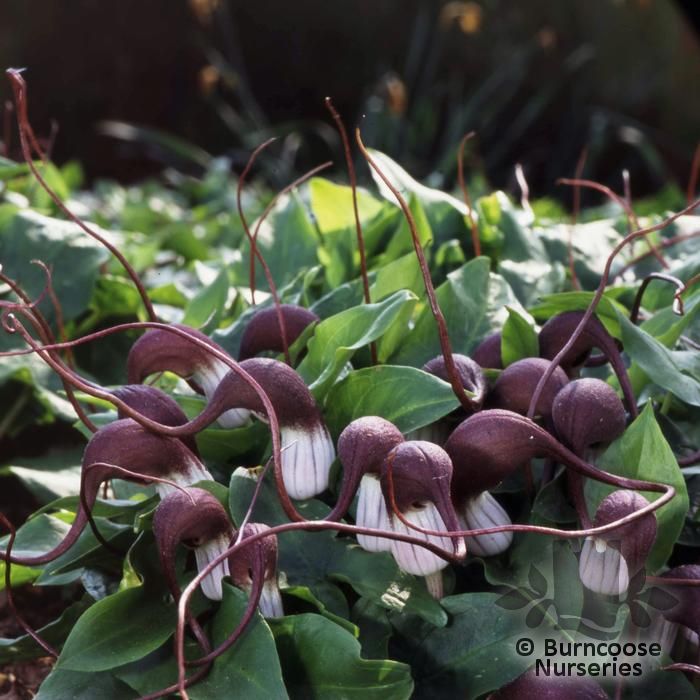
Arisarum proboscideum – Mouse tail plant. This is another plant I first saw in England. I was taking a botanical water color class and we had to go into the garden and chose a subject. I loved this little plant that looks like mouse bottoms in the air! I still do. It spreads and seems like there are hundreds of mice looking for something they lost!
Tell me of the things you love and can’t live without in your garden. Tell me your favorite web site for plant hunting. How about the things someone gave you that mean something special! Plants are more that just beautiful. They tell stories of where we have been, who we were at one time, and people we have met along the way that add to out lives in a myriad of ways.

 This is a beautiful coastal garden in the Point White area of Bainbridge Island. The clients are not here in the winter but come back in the late spring to the blooms I’ve planned for them.
This is a beautiful coastal garden in the Point White area of Bainbridge Island. The clients are not here in the winter but come back in the late spring to the blooms I’ve planned for them. The paver driveway is good for the moist site and any excess water is directed down the edge drains. A combination of grasses, heathers, sedums are on raised berms to keep their feet from getting too wet.
The paver driveway is good for the moist site and any excess water is directed down the edge drains. A combination of grasses, heathers, sedums are on raised berms to keep their feet from getting too wet. The owners requested evergreens and good blooms, they also love hydrangea (aka deer candy). We tucked these in close to the front door so they can be enjoyed and are less likely to be eaten. One thing the deer have eaten are the blooms off the Bergenia. The leaves are fine but the blooms are gone. Who knew?
The owners requested evergreens and good blooms, they also love hydrangea (aka deer candy). We tucked these in close to the front door so they can be enjoyed and are less likely to be eaten. One thing the deer have eaten are the blooms off the Bergenia. The leaves are fine but the blooms are gone. Who knew? Design Tips:
Design Tips:
























































